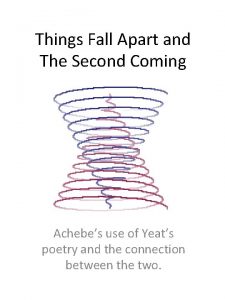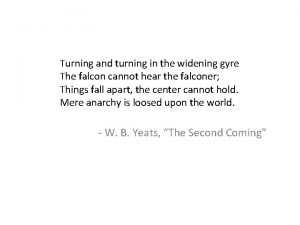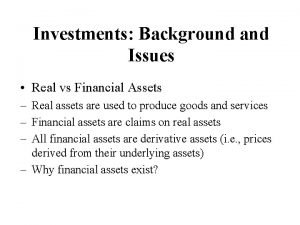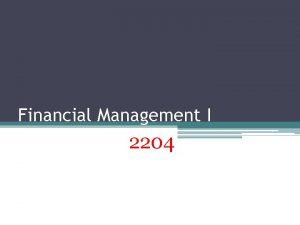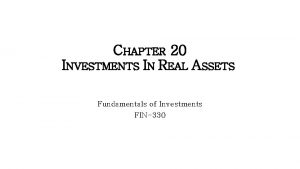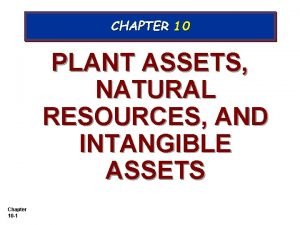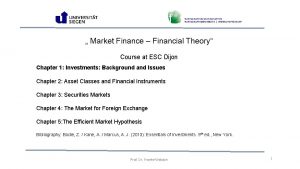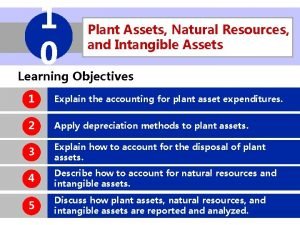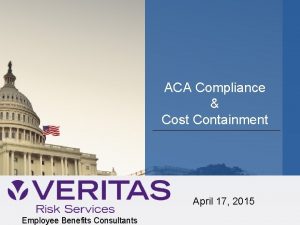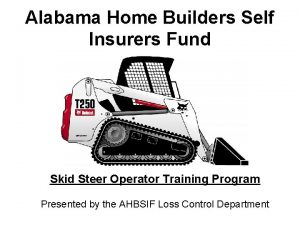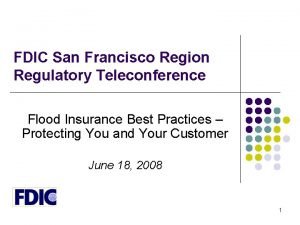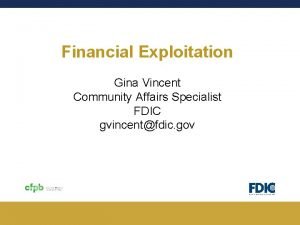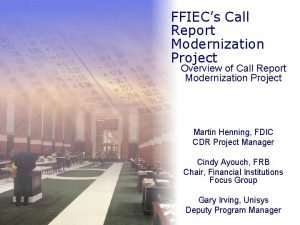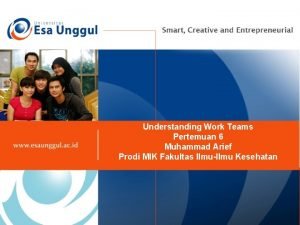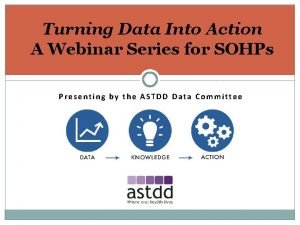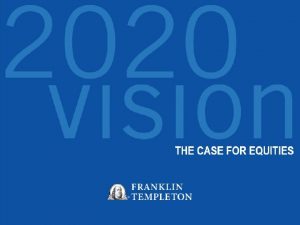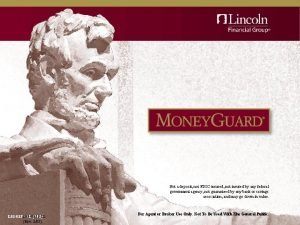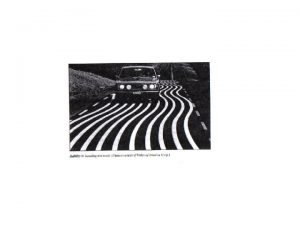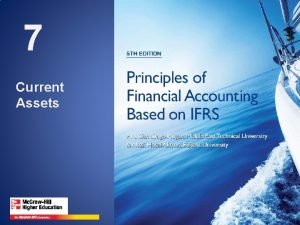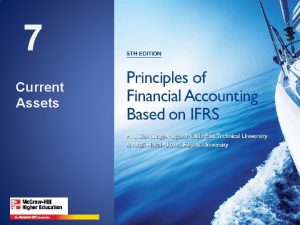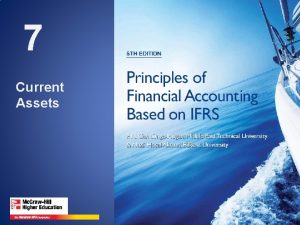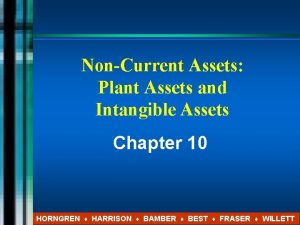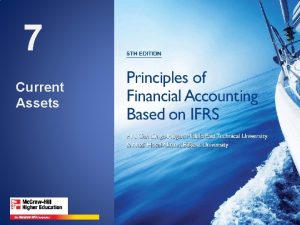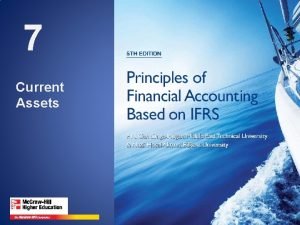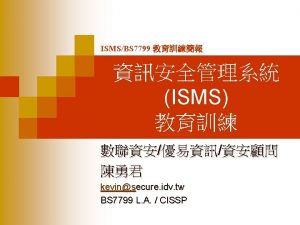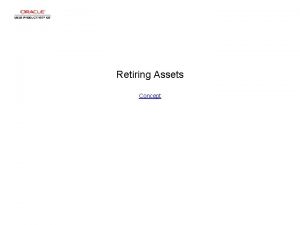Turning IRA assets into income Not FDIC insured





























- Slides: 29

Turning IRA assets into income Not FDIC insured May lose value No bank guarantee Planning how to take IRA distributions as you approach retirement.

Turning IRA assets into income Three misconceptions PPT 032 307716 8/17 1 You can’t take a distribution before age 59½ without penalty 2 Calculating required minimum distributions is complicated 3 Tax benefits stop at the death of the IRA owner 2

Turning IRA assets into income Don’t let penalties before age 59½ erode your savings • Access your IRA penalty free through substantially equal periodic payments Premature distribution Penalty for distributions Age 59½ Normal distribution Age 70½ No penalty for distributions Required minimum distribution Must begin distributions Withdrawals are subject to income tax, and those made before age 59½ may be subject to an additional 10% tax. PPT 032 307716 8/17 3

Turning IRA assets into income Utilize Rule 72(t) strategy for penalty-free distributions • You must take systematic payments for five years or until you reach age 59½, whichever is longer • Avoids the usual 10% additional tax on taxable IRA distributions made before age 59½* * Distributions taken prior to reaching age 59½ are normally subject to an additional 10% tax. Distributions of deductible contributions and earnings will be subject to federal income tax. PPT 032 307716 8/17 4

Turning IRA assets into income How does it work? Bob retires at age 50 He must stick to the distribution schedule for 9. 5 years (until age 59½) Sally retires at age 57 She must stick to the distribution schedule for 5 years (until age 62) PPT 032 307716 8/17 5

Turning IRA assets into income The method you take makes a difference Distribution method Life expectancy Amortization Annuity Year 1 $2, 924 $3, 699 $3, 681 Year 2 3, 148 3, 699 3, 681 Year 3 3, 400 3, 699 3, 681 Year 4 3, 661 3, 699 3, 681 Year 5 3, 940 3, 699 3, 681 A one-time switch from either the “amortization” or the “annuity” method to the “life expectancy” method. This hypothetical example assumes a 50 -year-old, traditional IRA owner, an account balance of $100, 000 with an 8% annualized rate of return, and an interest rate of 1. 4% in conjunction with the IRS mortality table. Performance is not indicative of any Putnam fund, which will fluctuate. Not all required years of distribution are shown. PPT 032 307716 8/17 6

Turning IRA assets into income Three misconceptions PPT 032 307716 8/17 1 You can’t take a distribution before age 59½ without penalty 2 Calculating required minimum distributions is complicated 3 Tax benefits stop at the death of the IRA owner 7

Turning IRA assets into income Mapping your RMD involves careful planning • You must start taking distributions from your traditional IRA by April 1 of the year after you turn 70½* • IRA regulations make taking distributions easy and relatively favorable Age from a tax standpoint Age Premature distribution Penalty for distributions 59½ Normal distribution No penalty for distributions 70½ Required minimum distribution Must begin distributions * Note that these distributions are required of traditional IRA owners. Roth IRA owners are not required to take distributions during their lifetime. PPT 032 307716 8/17 8

Turning IRA assets into income Four facts to remember about RMDs Just keep in mind Date You must start taking minimum distributions by April 1 of the year after you turn 70½ Calculation method There is one simple calculation method* Beneficiary You may change beneficiaries whenever you wish without affecting the amount of your lifetime distributions Penalty for failure to withdraw Equal to 50% of the required minimum distribution not taken * IRA owners who have a spousal beneficiary who is more than ten years younger than the IRA owner may opt to use the IRS joint life expectancy table. PPT 032 307716 8/17 9

Turning IRA assets into income Three misconceptions PPT 032 307716 8/17 1 You can’t take a distribution before age 59½ without penalty 2 Calculating required minimum distributions is complicated 3 Tax benefits stop at the death of the IRA owner 10

Turning IRA assets into income Extend the life of tax advantages with a Stretch IRA • Extend tax deferral • Increase compounding potential • IRA income for heirs Premature distribution Penalty for distributions PPT 032 307716 8/17 Age 59½ Normal distribution No penalty for distributions Age 70½ Required minimum distribution Must begin distributions 11

Turning IRA assets into income Spousal beneficiary • Once RMD for the year of death has been made, a spouse beneficiary may take over decedent’s IRA and treat it as his or her own (assuming certain requirements are met) – Spouse can calculate RMDs, if required, based on the uniform distribution table – Name new beneficiaries • Spouse can also transfer funds to a beneficiary IRA – If the beneficiary spouse is under age 59½, he or she can access the IRA assets immediately without incurring a 10% early withdrawal penalty – Spouse beneficiary may still opt to treat the beneficiary IRA as his or her own at any time in the future PPT 032 307716 8/17 12

Turning IRA assets into income How does it work? Spousal beneficiary example Bob (age 65) rolls $200 K into an IRA and names wife, Sally (age 60), as sole beneficiary. Year 0 PPT 032 307716 8/17 Year 5 Year 10 Year 12 Year 49 13

Turning IRA assets into income How does the spousal beneficiary work? Bob dies at age 70. Before commencing RMDs, Sally (age 65) elects to treat the IRA as her own and designates their son, Bruce (age 40), as her IRA beneficiary. RMDs have not started. Year 0 PPT 032 307716 8/17 Year 5 Year 10 Year 12 Year 49 14

Turning IRA assets into income How does the spousal beneficiary work? Sally dies in year 10 at age 70 before commencing RMDs. The following year, Bruce (age 45) begins receiving payments Year 11 based on his (much longer) life distribution expectancy under the new IRS $12, 019 regulations. He names his Year 0 Year 10 Year 20 Year 30 Year 40 Year 50 wife, Wendy, as his A total of $3. 2 million in income based upon an initial investment of $200, 000 and cumulative annual distributions of 39 years. This hypothetical illustration assumes an 8% annualized return and that distributions are kept to the required minimum. It does not represent the performance beneficiary. of any Putnam fund or investment. Investors should consider various factors that can affect their decision, such as possible changes to tax laws, the impact of inflation, and other risks including periods of market volatility when investment return and principal value may fluctuate with market conditions. Year 0 PPT 032 307716 8/17 Year 5 Year 10 Year 12 Year 49 15

Turning IRA assets into income How does the spousal beneficiary work? $270, 526 Bruce dies at age 74. Wendy continues the established distribution schedule. No rollover is available. Year 49 distribution $124, 329 $12, 019 Year 11 distribution Year 0 Year 10 $24, 506 Year 20 distribution Year 20 Year 40 distribution $54, 566 Year 30 distribution Year 30 Year 40 Year 50 A total of $3. 2 million in income based upon an initial investment of $200, 000 and cumulative annual distributions of 39 years. This hypothetical illustration assumes an 8% annualized return and that distributions are kept to the required minimum. It does not represent the performance of any Putnam fund or investment. Investors should consider various factors that can affect their decision, such as possible changes to tax laws, the impact of inflation, and other risks including periods of market volatility when investment return and principal value may fluctuate with market conditions. PPT 032 307716 8/17 16

Turning IRA assets into income How does the spousal beneficiary work? Total of 39 annual distributions $3, 200, 000 was distributed from the account Year 0 Year 10 Year 20 Year 30 Year 40 Year 50 A total of $3. 2 million in income based upon an initial investment of $200, 000 and cumulative annual distributions of 39 years. This hypothetical illustration assumes an 8% annualized return and that distributions are kept to the required minimum. It does not represent the performance of any Putnam fund or investment. Investors should consider various factors that can affect their decision, such as possible changes to tax laws, the impact of inflation, and other risks including periods of market volatility when investment return and principal value may fluctuate with market conditions. PPT 032 307716 8/17 17

Turning IRA assets into income Non-spousal beneficiaries • IRA owner may designate a non-spousal beneficiary, including a minor • Upon reaching age 70½, owner begins RMDs • When IRA owner dies, the beneficiary may establish RMDs based on his/her own life expectancy and name a new beneficiary, * even if RMDs have already started * Special rules may apply if the designated non-spouse beneficiary is a non-person, such as an estate, trust, or charitable organization. PPT 032 307716 8/17 18

Turning IRA assets into income How does the non-spousal beneficiary work? Betty (age 60) rolls $200 K into an IRA. She names her sons — Max, age 34, and Sam, age 40 — as beneficiaries. Year 0 PPT 032 307716 8/17 Year 5 Year 10 Year 12 Year 49 19

Turning IRA assets into income How does the non-spousal beneficiary work? Betty begins RMDs using the IRS’s simple calculation method. Year 10 distribution = $16, 480 Year 0 PPT 032 307716 8/17 Year 5 Year 10 Year 12 Year 49 20

Turning IRA assets into income How does the non-spousal beneficiary work? Betty dies at age 72 after receiving $53, 443 in distributions over 3 years. IRA is split evenly between sons Max and Sam. Year 0 PPT 032 307716 8/17 Year 5 Year 10 Year 12 Year 49 21

Turning IRA assets into income How does the non-spousal beneficiary work? Sam (now age 52) decides to liquidate his portion of the account immediately. Sam’s lump-sum distribution = $243, 158 Year 0 PPT 032 307716 8/17 Year 5 Year 10 Year 12 Year 49 22

Turning IRA assets into income How does the non-spousal beneficiary work? $243, 158 140 000 120 000 Sam receives $243, 158. 100 000 In the year following Betty’s death, 80 000 year 13, Max (now age 47) begins 60 000 taking distributions based on his single life expectancy. 40 000 20 000 0 Year Sam Annual distributions: Betty 1 10 12 Max Year 49 This hypothetical example assumes an 8% annualized return with distributions on an initial $200, 000 investment based initially on the uniform distribution table. After the owner’s death, distributions are based on the non-recalculated single life expectancy of a single beneficiary. Distributions are taken at the end of the year and are kept to the required minimum. Performance is not indicative of any Putnam fund. Year 0 PPT 032 307716 8/17 Year 5 Year 10 Year 12 Year 49 23

Turning IRA assets into income How does the non-spousal beneficiary work? $243, 158 140 000 120 000 100 000 Max’s IRA is depleted. Total of $1, 436, 936 80 000 is received in distributions. 60 000 40 000 20 000 0 Year Annual distributions: Betty 1 10 12 Sam Max Year 49 This hypothetical example assumes an 8% annualized return with distributions on an initial $200, 000 investment based initially on the uniform distribution table. After the owner’s death, distributions are based on the non-recalculated single life expectancy of a single beneficiary. Distributions are taken at the end of the year and are kept to the required minimum. Performance is not indicative of any Putnam fund. Year 0 PPT 032 307716 8/17 Year 5 Year 10 Year 12 Year 49 24

Turning IRA assets into income How does the non-spousal beneficiary work? Total distributions $1 436 936 Max has received over $1 million more than Sam. $243 158 $53 443 Betty Sam Max This hypothetical example assumes an 8% annualized return with distributions on an initial $200, 000 investment based initially on the uniform distribution table. After the owner’s death, distributions are based on the non-recalculated single life expectancy of a single beneficiary. Distributions are taken at the end of the year and are kept to the required minimum. Earnings on Sam’s distribution are not reflected. Performance is not indicative of any Putnam fund. PPT 032 307716 8/17 25

Turning IRA assets into income Three helpful facts for planning retirement • You can take a distribution before age 59½ without penalty • Calculating RMDs is straightforward • Tax benefits can continue after the death of the IRA owner PPT 032 307716 8/17 26

Turning IRA assets into income What’s next? • Consider how much IRA income you may need in retirement • Check your IRA beneficiary designations, but know that they can be changed without affecting RMDs • Ask your financial representative about ways to help make the most of your IRA PPT 032 307716 8/17 27

Turning IRA assets into income This information is not meant as tax or legal advice. Please consult your legal or tax advisor before making any decisions. This material is for informational and educational purposes only. It is not a recommendation of any specific investment product, strategy, or decision, and is not intended to suggest taking or refraining from any course of action. It is not intended to address the needs, circumstances, and objectives of any specific investor. Putnam, which earns fees when clients select its products and services, is not offering impartial advice in a fiduciary capacity in providing this sales and marketing material. This information is not meant as tax or legal advice. Investors should consult a professional advisor before making investment and financial decisions and for more information on tax rules and other laws, which are complex and subject to change. Investors should carefully consider the investment objectives, risks, charges, and expenses of a fund before investing. For a prospectus, or a summary prospectus if available, containing this and other information for any Putnam fund or product, call your financial representative or call Putnam at 1 -800 -225 -1581. Please read the prospectus carefully before investing. Putnam Retail Management putnam. com PPT 032 307716 8/17 28

 May lose value
May lose value May lose value
May lose value Not fdic insured may lose value
Not fdic insured may lose value Not fdic insured may lose value
Not fdic insured may lose value The second coming things fall apart
The second coming things fall apart Wb yeats the second coming
Wb yeats the second coming Turning and turning in the widening gyre
Turning and turning in the widening gyre Financial assets vs real assets
Financial assets vs real assets Real assets vs financial assets
Real assets vs financial assets Types of real assets
Types of real assets Plant assets natural resources and intangible assets中文
Plant assets natural resources and intangible assets中文 Plant assets natural resources and intangible assets
Plant assets natural resources and intangible assets Lanni products is a start up computer
Lanni products is a start up computer Plant assets, natural resources, and intangible assets
Plant assets, natural resources, and intangible assets Self funded vs fully insured
Self funded vs fully insured Alabama home builders self insurance fund
Alabama home builders self insurance fund Personal income formula
Personal income formula Carrying value formula
Carrying value formula Operating activities
Operating activities Accounting income vs taxable income
Accounting income vs taxable income Fdic/jfsr bank research conference
Fdic/jfsr bank research conference Money smart fdic
Money smart fdic Fdic flood insurance
Fdic flood insurance Fdic community affairs
Fdic community affairs Martin henning fdic
Martin henning fdic Fdic affordable housing program
Fdic affordable housing program Turning great strategy into great performance
Turning great strategy into great performance Megan lemons
Megan lemons Understanding work teams
Understanding work teams Turning data into action
Turning data into action




